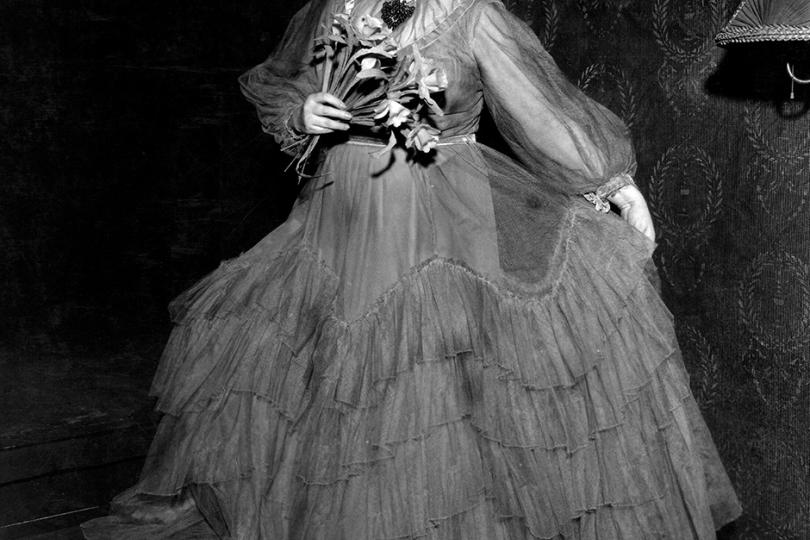Laurette Taylor, Eva La Gallienne and Sylvia Sidney

In Rick McKay’s documentary, Broadway: The Golden Age, many Icons of the 50s and 60s, (several to be discussed here later), address the most influential performance they’ve ever seen. That performance was given by the natural-born actress who played Amanda Wingfield in the original 1945 production of Tennessee Williams’ The Glass Menagerie. Those who saw it described her as “mesmerizing,” and returned to see her multiple times.
Laurette Taylor
She’s been essentially forgotten, but Laurette Taylor (1883-1946) was once renowned. Noel Coward based the character of Judith Bliss in Hay Fever on Taylor. Her husband, J. Hartley Manners wrote Peg O’ My Heart, a gigantic hit of the 1920s for her. However, because she was an alcoholic, she didn’t work for long stretches of time. Her performance in the 1938 revival of Outward Bound was almost as acclaimed as her Amanda Wingfield.
The Glass Menagerie
There’s a famous, possibly mythic, story about Taylor, who was missing in Chicago before the premiere performance, prior to its Broadway engagement. She was found in a room under the stage, where she was dyeing one of her costumes, because she thought it should look different. The story varies from an apron to the gown Amanda wears in the Second Act, but it adds to Taylor’s allure. Of course, the play received the kind of reviews we all wish for, and she was honored as Best Actress by the New York Critics Circle.
Conversely, things weren’t perfect for her. Betsy Blair, an understudy for the show, observed that sometimes during performances Taylor would leave the stage to vomit into a basin and go back onstage, but it all seemed to be part of the action. Her essay on acting, "The Quality Most Needed,” where she spoke of using imagination and about falseness in acting, was part of the text for Actors on Acting.
Laurette Taylor died at the age of 63, and is interred at Woodlawn Cemetery in the Bronx. Except for a screen test and a few cuts from her silent movies, little exists of Taylor’s acting. Her daughter, Marguerite Courtney, wrote a thoughtful biography of her mother, but the memories don’t end there.
Tributes
Fifteen years after her death, Judy Holliday made her last stage appearance as Taylor in Laurette, due to Holliday’s health it never reached Broadway. Mary Martin starred in the musical failure Jennie, based on Taylor’s early years in the theater. Peggy Wood (The Sound of Music) appeared off-Broadway in a one-act, Opening Night, based on Taylor’s career. Laurette Taylor may never have a theater named for her, but it’s time for her to be rediscovered. Some of her recording are available on YouTube.
Adventurous Theater Artist
Eva Le Gallienne (1899-1991) was, perhaps, the most adventurous and, yes, influential, woman of the theater. Always sure of herself, the British-born actress joined Ethel Barrymore’s repertory company in the early 1920s. She made a name for herself as Julie Jordan in Ferenc Molnar’s play, Liliom, (the source for the musical Carousel), co-starring with Joseph Schildkraut, (an Oscar winner for The Diary of Anne Frank). They also starred together in Molnar’s The Swan.
Le Gallienne never hid her homosexuality, and had affairs with both actress Alla Nazimova, and writer Mercedes de Acosta, whose play for Le Gallienne, Jehanne d’Arc would be a failure.
Her Muse
Like many at the time, Le Gallienne admired the renowned British actress, Eleanora Duse, who, like Ellen Terry and Sarah Bernhardt, was regarded as one of the greatest actresses of the era. Seeking advice, Duse wrote to her, telling her to be “sure of herself” and remember that “you are in the light.” Le Gallienne heeded her advice and always sought realism in the theater.
Civic Rep
In 1926, she took over the 14th Street Theater in the West Village and established the Civic Repertory. For eight years, the theater produced 34 successful productions, and while the ensemble boasted such actors as Burgess Meredith (Batman, Rocky) and John Garfield (The Postman Always Rings Twice), she notably rejected Bette Davis as “insincere and frivolous.” The Civic Repertory had a wide, varied repertoire that included Peter Pan and the premiere of Alison’s House, Susan Glaspell’s Pulitzer Prize-winning play about Emily Dickinson. She cast Nazimova in The Cherry Orchard, and Le Gallienne herself played Hedda Gabler, for the first time (she eventually played it six different times). Actress and teacher Uta Hagen (Who’s Afraid of Virginia Woolf?) played Ophelia to Le Gallienne’s Hamlet.
Her script for Alice in Wonderland remains the finest dramatization of the novel and has been produced frequently. In 1982, she portrayed the White Queen in a revival, later broadcast on American Playhouse. Kate Burton played the title role, and her father, Richard played the White Knight.
Awards and Honors
Eva Le Gallienne was honored with a special Tony Award for her work in the Repertory Theater movement. She was honored with the National Medal of Arts, and won an Emmy for her role in The Royal Family, also broadcast on PBS. She was nominated for an Oscar for her performance as Ellen Burstyn’s grandmother in Resurrection. Eva Le Gallienne passed on in 1991 at the age of 92. With Alice in Wonderland; and Resurrection both available on YouTube, her fine acting work is readily available.
Her smile, her voice, her eyes
Bronx-born Sophie Kosow wanted to be an actress, so in 1925, she enrolled at the Theater Guild School. She was expelled for staying out after curfew, but made her Broadway debut two years later. It launched a career that lasted seven decades. First, though, she changed her name to Sylvia Sidney (1910-1999).
Sylvia Sidney began the first of eight Broadway shows with Crime in 1927. She continued working onstage until 1930, when she was signed to a contract with Paramount Pictures, and under the guidance of B.P. Schulberg, with whom she had an affair, topped a roster that included Marlene Dietrich and Claudette Colbert. Sylvia Sidney was a smart cookie, who’s resume includes several revolutionary films.
She replaced Jessica Tandy in The Fourposter (1952) and a decade later played Mrs. Banks in Barefoot in the Park. Her last Broadway role was Mrs. Wire in Tennessee Williams’ beautiful play, Vieux Carre, in the mid-70s, but she continued working in theater throughout her life. A lifelong smoker, she was easily identified by her husky voice, but she had an unbeatable smile and emotional eyes, which she said had her “paid by the teardrop.”
Film Career Highlights
When Hollywood’s “It” Girl, Clara Bow, had a nervous breakdown, Sidney replaced her in City Streets, costarring Gary Cooper; she portrayed the pregnant shop girl who’s drowned in Theodore Dreiser’s American Tragedy (it was remade as A Place in the Sun with Shelley Winters in Sidney’s role); she received top billing for her appearance in Street Scene, and co-starred with Cary Grant in Madame Butterfly, The Thirty-Day Princess and Merrily We Go to Hell. Along with Fred MacMurray and Henry Fonda, she starred in The Trail of the Lonesome Pine, important because it’s the studio’s first film made in technicolor.
You Only Live Once
While her personal favorite film was Mary Burns, Fugitive, in 1935, she was loaned to MGM, where she appeared opposite Spencer Tracy in Fritz Lang’s Fury. She loved working with Lang, so, after an unpleasant experience with Alfred Hitchcock (Sabatoge), she and Henry Fonda starred in Fritz Lang’s You Only Live Once, about a couple on a crime spree. This film was Arthur Penn’s inspiration later when he was making Bonnie and Clyde. She would also star in Lang’s You and Me, a clever comedy about ex-cons planning to rob a department store.
Her film career diminished during the 1940s, although she gave standout performances in Mr. Ace, with frequent costar George Raft and in Blood on the Sun opposite James Cagney. In 1949 exhibitors voted her "box office poison", but in 1952, she returned to the screen opposite Michael Rennie, portraying Fantine in Les Miserables. Her performance was widely praised and gave her the opportunity of developing into a character actress.
Luther Adler
Following a brief marriage to writer Bennett Cerf, in 1938, she married actor and teacher Luther Adler. For the next nine years they toured in play after play. Their only child, Jacob was born in 1939, but in 1987 would succumb to ALS. (Sidney worked tirelessly to bring attention to the disease) Her sister-in-law was acclaimed drama teacher Stella Adler.
Television Roles
Early television brought work for many actors, and Sidney’s most notable performance at this time was as the mother of Helen Morgan (Show Boat), opposite Polly Bergen in The Helen Morgan Story. She would appear on such series as Route 66, The Defenders, My Three Sons and The Love Boat.
She teamed with Helen Hayes, Mildred Natwick and Myrna Loy for Do Not Fold, Spindle or Mutilate, a made-for-TV thriller co-starring Vince Edwards. This led to the only film for which she would receive an Oscar nomination, playing Joanne Woodward’s mother in Summer Wishes, Winter Dreams. Another important film was An Early Frost, for which she won a Golden Globe. The first film about a family dealing with the AIDS crisis, she played Aiden Quinn’s grandmother. She played the challenging Miss Coral in the film version of I Never Promised You a Rose Garden, and Valerie Harper’s dying mother in The Shadow Box. TV work included WKRP, thirtysomething, Magnum PI and Trapper John, MD. In 1982, Sidney was awarded George Eastman Award for distinguished contribution to the art of film.
Tim Burton
A longtime fan of Sylvia Sidney, Tim Burton, treated her like a movie star when he cast her in Beetlejuice, as Juno, the chain-smoking social worker in the afterlife. Her last film was Mars Attacks, in which she played “Grandma,” whose love for Slim Whitman has explosive results. She was working on the short-lived late-1990s revival of Fantasy Island when she died from throat cancer a month shy of her 89th birthday.
These are three women are important to our theater’s past because of their dedication and ambition. They may be gone, but they can still teach us much about the profession.




